I have been to Split Croatia more times than I planned, and every visit has pulled me in a little deeper. The city has a way of getting under your skin. One moment you are walking through Diocletian’s Palace, running your hand along stone walls that have been standing since the fourth century, and the next you are sitting at a café that feels like someone’s living room. The mix of ancient history and everyday life never gets old.
What keeps me coming back is the energy. Split Croatia is not a quiet museum city. It feels lived in and real. You see older locals chatting on benches in the shade and kids racing down the Riva with gelato dripping down their hands. Ferries slide in and out of the harbor all day, and the sound of their horns becomes part of the background. Mornings often start with sunlight hitting the rooftops of the old town, and nights end with music drifting through the squares near the water.
The weather helps too. I have been in summer when the heat pushes you toward the nearest beach, and in spring and autumn when the crowds thin out and the city feels softer. Even in winter, many cafés stay open, and walking through the palace with fewer people around feels almost private. Split Croatia works in every season, which is rare for a coastal city.
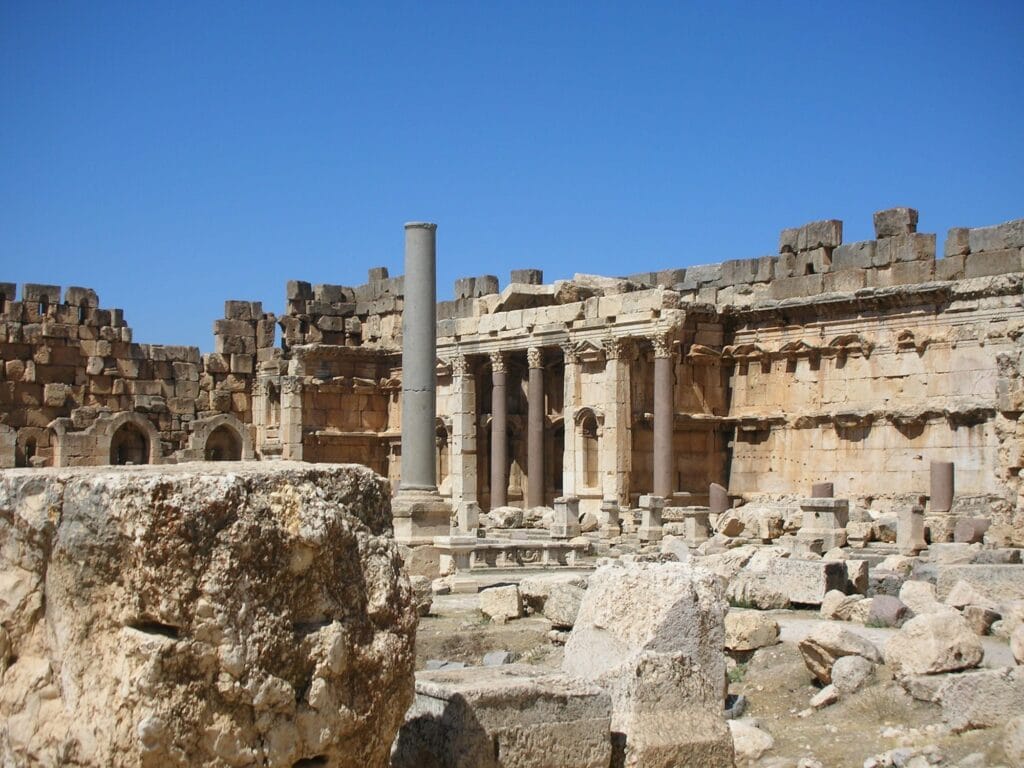
How Many Days Do You Need In Split Croatia?
For a first visit, plan at least two full days in Split Croatia. That is enough time to see Diocletian’s Palace, wander the old town, stroll the Riva and climb Marjan Hill. If you love history, beaches or boat trips, three to five days will feel even better.
Remember that Split is also the main gateway to the wider Dalmatian coast. Extra days let you add ferry trips to nearby islands or quick bus rides to medieval towns and ancient ruins.
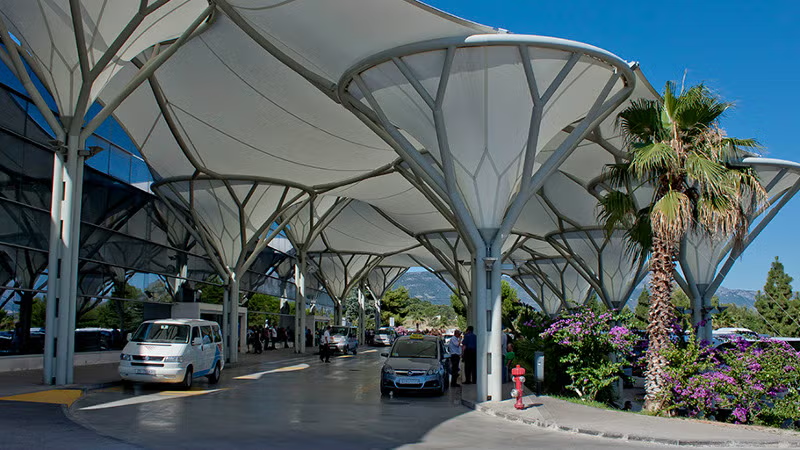
Getting To Split And Getting Around
Split has an international airport about thirty minutes outside the city. In high season, direct flights link the city with many European hubs. From the airport you can take a shuttle bus, local bus, taxi or ride share into town.
If you arrive by train or long distance bus, you will end up right next to the ferry port and within a short walk of the old town and Riva.
Once you are in the center, you will not need a car most of the time. The historic core of the city is compact and very walkable. Streets are narrow and often paved with smooth stone, so comfortable shoes are important. Local buses connect the suburbs, beaches and shopping areas.
Ferries and catamarans run from the main port to islands such as Hvar, Brač, Vis and Korčula, with extra departures in summer.
Top Historic Sites In Split Croatia

Diocletian’s Palace
Diocletian’s Palace is the heart of Split Croatia and a UNESCO World Heritage site. Built at the end of the third century for the Roman emperor Diocletian, it was part fortress, part villa and part small town. Today its walls form much of the old city. You can wander narrow alleys, stumble into tiny courtyards and look up at layers of Roman, medieval and modern stonework.
Do not miss the Peristyle, the central square framed by columns, where live music often echoes at night. Beneath the palace, the cellars hold vaulted halls that once supported the emperor’s living quarters. Parts of Game of Thrones were filmed here, so fans may recognize the setting as Meereen.
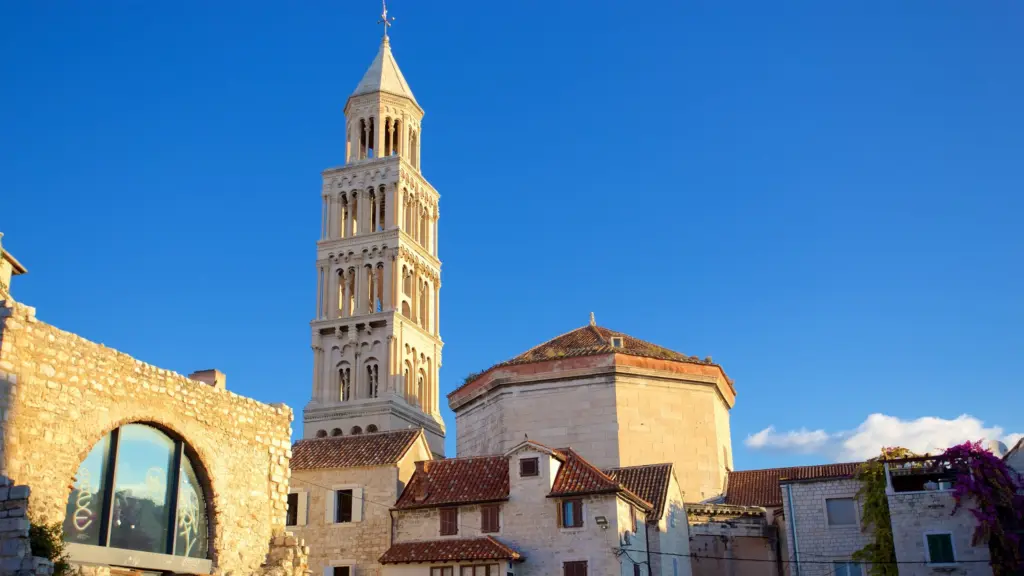
Cathedral of Saint Domnius and Bell Tower
Inside the palace complex stands the Cathedral of Saint Domnius, which started as Diocletian’s mausoleum before being turned into a church. It is one of the oldest Catholic cathedrals still in use. Step inside to see carved stone, wooden choir stalls and rich religious art.
For the best view in Split Croatia, climb the bell tower. The steps are steep, but from the top you can see red roofs, the harbor, nearby islands and the green shape of Marjan Hill.

Temple of Jupiter and Other Roman Remains
The small Temple of Jupiter, once dedicated to the Roman god of thunder, now contains a baptismal font and a statue of Saint John. Outside stands a black granite sphinx brought from Egypt, a reminder of how wide the Roman world once stretched. Around the palace you will spot fragments of gates, walls and columns that hint at the size of the original complex.
Museums Worth Your Time
If you want to understand Split Croatia on a deeper level, the city’s museums add important context. They are small enough to enjoy in a couple of hours but rich enough to give you a stronger sense of Dalmatian history and culture.

Split City Museum
This museum sits inside a former noble palace and walks you through how Split Croatia grew from a Roman retirement complex into a real city. You will find maps, old photos, carved stone pieces from the palace walls and everyday objects used by people who lived here centuries ago. It is a great way to connect the ruins you see outside with the stories behind them.
Archaeological Museum
This is the oldest museum in Croatia and one of the most impressive. It holds thousands of Roman, Greek and early Christian artifacts found around Dalmatia. Expect to see mosaics, ancient coins, marble statues, stone inscriptions and parts of old temples and churches. The outdoor garden, filled with stone monuments and sarcophagi, is just as interesting as the indoor exhibits.
Ethnographic Museum
Set near the heart of Diocletian’s Palace, this museum focuses on traditional Dalmatian life. You can explore displays of folk clothing, handmade lace, farming tools, cooking items and religious objects. It gives you a sense of how people lived in this region long before Split Croatia became a major travel destination.

Mestrovic Gallery
Located in a beautiful villa overlooking the sea, this museum celebrates the work of Ivan Meštrović, one of the most respected Croatian sculptors. His wood carvings, marble statues and bronze works fill the rooms and gardens. Even if you are not usually a museum person, the peaceful surroundings and ocean views make this place worth a visit.
Hidden Alleys, Neighborhoods And Local Life
Many visitors stay close to the palace walls, but some of the most charming corners of the city lie just beyond.
Spend time in Veli Varoš, a hillside neighborhood of stone houses, tiny chapels and tangled lanes. It feels like a small village inside the city and shows how ordinary people have lived here for centuries.
Radunica, another historic area east of the palace, is known for its summer street festival. Even outside festival time it is pleasant to stroll, with laundry strung above the lanes, children playing outside and small konobas serving simple Dalmatian food.
Do not miss the markets. Pazar, the green market just outside the eastern gate, buzzes in the mornings with vendors selling fruit, vegetables, cured meats, cheese and homemade rakija. The fish market, or Ribarnica, near Marmontova Street, shows off the day’s catch and is a favorite of local chefs.

Eating, Drinking And Nightlife
Food is one of the big reasons people fall in love with the city. Traditional Dalmatian cooking focuses on fresh seafood, olive oil, herbs and seasonal produce. Look for grilled fish, octopus salad, black cuttlefish risotto and pašticada, a slow cooked beef dish often served with gnocchi.
For a simple and affordable meal, try a konoba tucked into an old town alley. For something more modern, head to bistros and wine bars along the Riva or in newer neighborhoods. Croatian wines, especially those from nearby islands, pair well with local dishes.
At night, the Riva waterfront promenade becomes the social heart of the city. Locals and visitors sip coffee or cocktails under palm trees while watching ferries and yachts slide past. In high season there is often live music and street performers. If you want louder nightlife, bars and clubs near Bačvice Beach and in the old town stay open late.
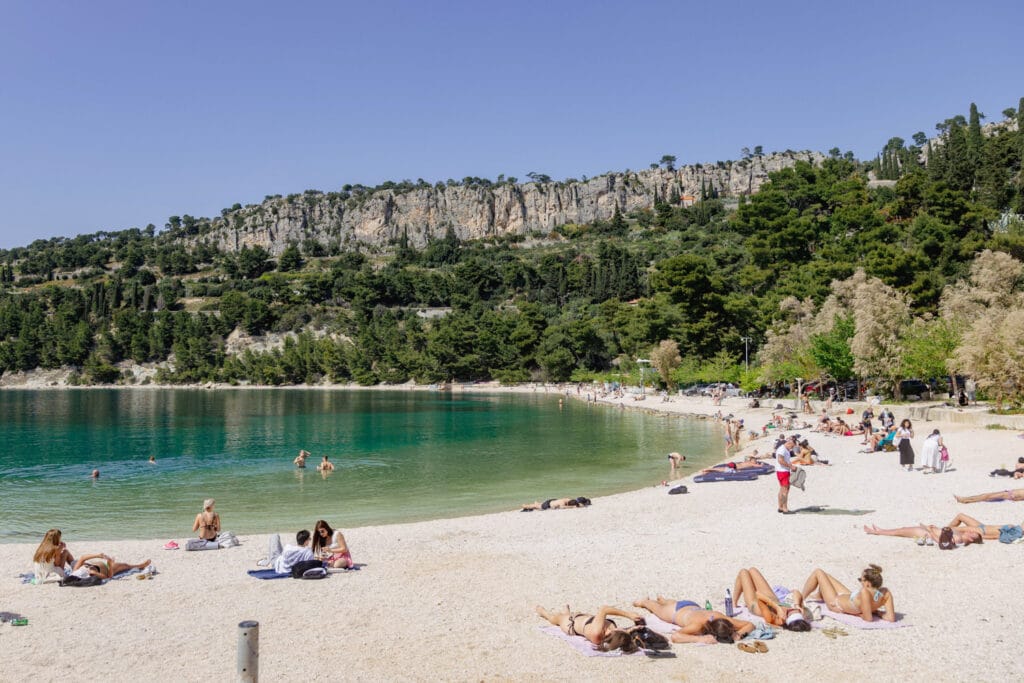
Beaches, Views And Outdoor Fun
Even if you come mainly for history, it is hard to resist the sea.
- Bačvice Beach is the closest beach to the center and one of the few sandy spots in the area. It is popular with families and younger crowds who play picigin, a local ball game in the shallows.
- Kasjuni Beach, on the southern side of Marjan Hill, is a pebbly bay with clear water, views of the forested hill and often a beach club with loungers.
- Kastelet, Ježinac and Bene sit along the Marjan peninsula and offer a mix of rocky coves, shade and small cafes.
- Žnjan Beach, to the east, has been undergoing a major renovation with new promenades, trees, playgrounds and facilities, turning it into a family friendly seaside zone.
Marjan Forest Park itself is one of the best places in the city to stretch your legs. Stairs and walking paths climb through pine woods to viewpoints where you can see the whole bay, the islands and the mountains behind town. You can hike, jog, rent a bike or simply sit on a bench and enjoy the fresh air.
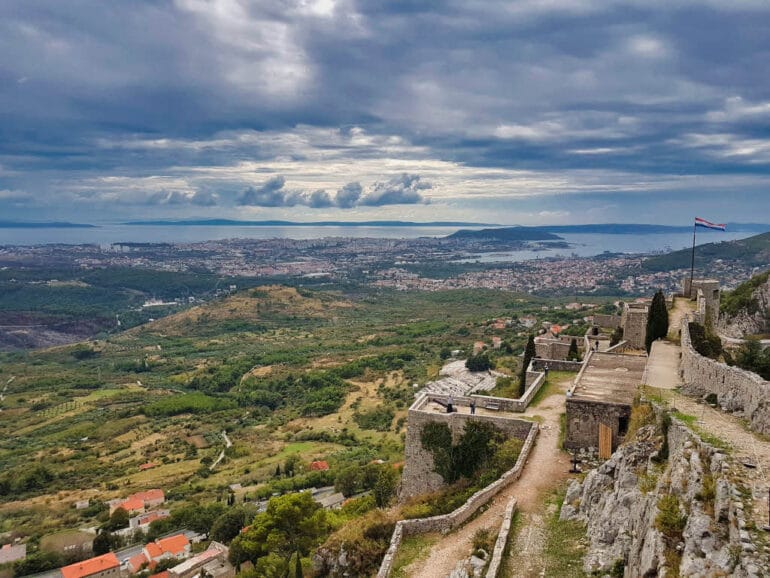
Best Day Trips From Split Croatia
One of the biggest benefits of staying in Split Croatia is how many incredible places are within easy reach.
- Trogir: A short bus or boat ride brings you to this small island town filled with medieval streets and a pretty waterfront. It feels like a fairy tale set and is perfect for a half day wander.
- Klis Fortress: Perched on a ridge above the city, this fortress guarded the main pass between the coast and inland Croatia. It offers sweeping views and also appeared in Game of Thrones.
- Salona and Solin: Just inland, the ruins of ancient Salona reveal theaters, baths and city walls from Roman times, while the modern town of Solin surrounds the site.
- Krka National Park: Popular tours run to this park where boardwalks pass close to waterfalls and emerald pools.
- Mostar or Plitvice Lakes: Longer day trips cross into Bosnia and Herzegovina or head north into central Croatia to see famous bridges and lakes.
Island Adventures From Split
Split’s busy ferry port makes island hopping easy. In summer, fast catamarans link the city with several islands many times per day.
- Hvar: Known for its historic harbor town, lavender fields and summer nightlife. You can visit on a day trip, but an overnight stay lets you enjoy it after day tours leave.
- Brač: Home to Zlatni Rat, a famous V shaped pebble beach that shifts shape with wind and currents.
- Vis and the Blue Cave: Vis sits farther out in the Adriatic and feels quieter and more remote. Boat tours often include a stop at the Blue Cave on nearby Biševo Island, where sunlight creates a bright blue glow inside the cavern.
- Korčula and Šolta: With more time you can connect ferries to reach these and other islands, each with its own towns, vineyards and coves.
Book tickets early in high season, especially for morning departures and popular routes like Split to Hvar.
Practical Tips For Visiting Split
- Best time to visit: Late May, June, September and early October bring warm weather with fewer crowds. July and August are hottest and busiest.
- Money: Croatia uses the euro. Cards are widely accepted, though small markets and buses may prefer cash.
- Language: Croatian is the official language, but many people in town speak at least basic English. Learning a few polite phrases such as hvala for thank you is always appreciated.
- Safety: The city is generally safe. Watch for pickpockets in crowded areas and keep an eye on your belongings at beaches and bus stations.
- Where to stay: Staying inside or near Diocletian’s Palace gives a magical experience, especially at night when day trippers leave. If you prefer beaches, look for places near Bačvice, Žnjan or the slopes of Marjan Hill.
- Respect the old town: Remember that the palace and surrounding lanes are not just historic sites but also people’s homes. Keep noise down late at night and do not leave litter.
Sample Three Day Split Itinerary
Day 1
Morning: Walk through Diocletian’s Palace, visit the Cathedral of Saint Domnius and explore the Peristyle and cellars.
Afternoon: Wander the old town streets and markets, then relax on the Riva with a coffee.
Evening: Enjoy dinner at a konoba followed by a slow stroll along the waterfront.
Day 2
Morning: Climb Marjan Hill for views, stopping at small chapels along the way.
Afternoon: Swim at Kasjuni or Bene Beach and enjoy a lazy seaside lunch.
Evening: Try a wine bar or live music venue in the old town.
Day 3
Option one: Take a day trip to Trogir or Klis Fortress.
Option two: Join a boat tour to Hvar or Vis for an island adventure.
Return to the city in the evening for a final walk through the glowing streets.
Why Split Croatia Stays With You
Many travelers arrive in Split Croatia thinking of it as a quick stop before heading to islands or national parks. Yet the city often becomes the highlight of their trip. The mix of Roman walls, narrow alleys, busy markets, clear water and easy day trips creates a rare balance of culture and relaxation.
If you give yourself time to wander the hidden corners, linger on the Riva and watch sunset from Marjan Hill, you will see why so many people return. Split Croatia is not just a place for a checklist of sights. It is a city that invites you to slow down, breathe in the sea air and feel part of a story that has been unfolding for more than seventeen centuries.
Frequently Asked Questions About Split Croatia
What is Split Croatia best known for?
Split Croatia is best known for Diocletian’s Palace, the Riva promenade and its easy access to nearby islands like Hvar, Brač and Vis. The mix of Roman history, beaches and lively local culture makes the city special.
How many days do you need in Split Croatia?
Plan to spend 2 to 4 days in Split Croatia to see the main sights. If you want to explore islands or take day trips along the Dalmatian Coast, 5 to 7 days is even better.
Is Split Croatia expensive to visit?
Split Croatia is more affordable than many Western European cities, but prices rise during July and August. Traveling in spring or fall helps keep costs down.
Is Split Croatia safe for tourists?
Yes. Split Croatia is very safe. Petty theft can occur in crowded places, but violent crime is uncommon. Basic awareness is all you need.
What is the best time to visit Split Croatia?
The best times to visit are May through June and September through October. The weather is warm, the sea is good for swimming and the city is less crowded.
Do you need a car in Split Croatia?
You do not need a car to explore Split Croatia. The old town and main attractions are walkable. A car helps only if you plan longer regional day trips.
Can you swim in Split Croatia?
Yes. Split Croatia has clear and calm beaches. Bačvice Beach is the most famous, while Kasjuni and Bene offer quieter options.
Is English widely spoken in Split Croatia?
Yes. Most people who work in tourism speak English well, especially younger locals, hotel staff and restaurant workers.
How do you get to the islands from Split Croatia?
Ferries and catamarans leave from the main port all day during the high season. Popular routes connect Split Croatia with Hvar, Brač, Vis and Korčula.
Is Split Croatia good for families?
Split Croatia is very family friendly. Kids enjoy the beaches, boat rides, ice cream shops and the open spaces inside Diocletian’s Palace.
